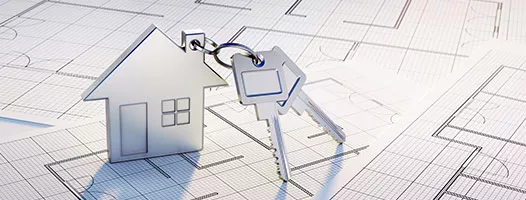Units Used to Describe the Size of Real Estate in Japan

In Japan, there are a number of units that describe area, such as 坪 (tsubo)・平米 (Heibei)・㎡ (Square meter)・畳 (Jo)・帖 (Jo)・歩 (Bu)・畝 (Se)・反 (Tan)・町 (Cho). In this article, we will explain the units that are widely used in the real estate industry, which you may see on advertisement drawings when you are looking for a property to buy or sell as well as a property to rent.
坪(Tsubo)
It is a unit based on the "Shakkan-ho" system, which was used before the introduction of the metric system in Japan. 1 tsubo is approximately 3.3 m2. It is often used to describe an area of land or office space.
Price per Tsubo
Property price, rent and construction cost per tsubo. In the Japanese real estate industry, the unit price per tsubo is often used to indicate the unit price per area of rent or property for sale.
Rent per tsubo: The sum of the property's rent and common service fee divided by the area (tsubo)
Property price per tsubo: The price of the property divided by the area (tsubo)
Price per tsubo of building price: The price of the building divided by the total floor area (tsubo)
平米 (Heibei)・㎡ (Square meter)
The area of a square whose sides are both 1 meter long and 1 meter wide. It is used for land area, floor area (building area), total floor area, exclusive area, etc.
In the 'Enforcement Rules for Fair Competition Codes Concerning Indication of Real Estate' set by the 'Real Estate Fair Trade Council of Federation', it is stated that ' the metric system must be used when indicating the area of land or the floor space of a building in an advertisement', so the use of平米 (Heibei) / ㎡ (Square meter) is obligatory in real estate advertisements (leaflets, internet, etc.).
畳 (Jo)
It means the size of one tatami mat. It is often used for the area of the living room. There are different types of tatami mats depending on the region, and each has a different size.
Kyoma (mainly used in the Kansai region): 1.82㎡
Edoma (mainly used in the Kanto region): 1.55㎡
Danchima (mainly used for apartments): 1.44㎡
The "Enforcement Rules for Fair Competition Codes Concerning Indication of Real Estate" stipulates that "the area per tatami mat shall be 1.62 square meters or more."
帖 (Jo)
The reason for using 帖(Jo) is that it can be used without any discomfort even in Western-style rooms with wooden or carpeted flooring, where tatami mats are not used. Like 1畳 (Jo), this is also stipulated as '1.62 m2 or more'.
*Both 1畳 (Jo) and 1 帖 (Jo) are just a guide to know the size. There is no specified indication of the exact area of the unit, and it is only stipulated that 1 jo (tatami mat) shall be 1.62 square meters or more. Before signing a real estate contract, we recommend that you always check the area by the number of square meters.
Quick Conversion Table
| 坪 (Tsubo) | 平米 (Heibei)・㎡ (Square meter) | 畳/帖 (Jo) |
| 1坪 | 3.3㎡ | 2畳 |
| 5坪 | 16.5㎡ | 10畳 |
| 10坪 | 33.1㎡ | 20畳 |
| 20坪 | 66.1㎡ | 40畳 |
| 30坪 | 99.2㎡ | 60畳 |
| 40坪 | 132.2㎡ | 80畳 |
| 50坪 | 165.3㎡ | 100畳 |
| 100坪 | 330.6㎡ | 200畳 |

- Furnished Monthly Apartments in Tokyo for Expats
- Fully furnished short-term rentals in Tokyo's expat areas
Wall-core area VS Inner area
There are two ways of indicating floor area: “Wall-core area” and “Inner area”.
Wall-core area
Floor area from the center line of pillars and walls
Since the thickness of the walls, etc. is included in the area, it is expressed larger than the actual usable area.
Used in application for building certification (Used for calculating Building Coverage Ratio and Floor-Area Raio)
Used in real property registration of detached houses
Used in application for mortgage deduction for detached houses
Inner area
Floor area inside the pillars and walls
The area of the actual usable space
Used in real property registration of building unit ownership such as condominium apartments
Used to apply for mortgage loan deduction for building unit ownership such as condominium apartments

The wall-core area is larger than the inner area because it includes the area equivalent of half-thickness of the wall. The difference depends on the structure of the building (wooden or reinforced concrete, etc.) and the thickness of the walls, but the smaller the area of the dwelling unit, the greater the difference. As a general guideline, it is said that there is a difference of about 11% for studio apartment units and about 6% for family-type apartment units.
In real estate advertisements, there is no rule on whether to use wall-core area or Inner area, but it seems that wall-core area is often used for newly built detached houses and newly built condominiums, and inner area is often used for preowned condominiums. When looking at the drawings, it is recommended to check whether wall core area or inner area is described.
Summary
Many people may be confused by the fact that the drawings of properties for sale and rent are described in various units, such as 坪(tsubo), m2 and畳(jo), but it may be useful when looking at the drawings to remember that 1 坪(tsubo) = 3.3 m2 = 2 畳(jo). You may also gradually get a better sense of the housing sizes after actually viewing some of houses or apartments.
The size of housing you need will depend on the number of people in your family, your desired lifestyle, etc. Room size, along with ceiling height, is one of the most important factors affecting the impression and comfort of your home. Please take a look at various houses and apartments and find your wonderful residence.

- Rental Apartments & Houses in Tokyo
- Listings of popular and luxurious rental apartments, condominiums, and houses designed with expats in mind.

- Apartments & Houses for Sale in Tokyo
- Listings of apartments, condominiums, and houses available for purchase in Tokyo.


















